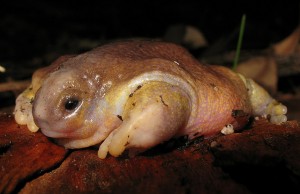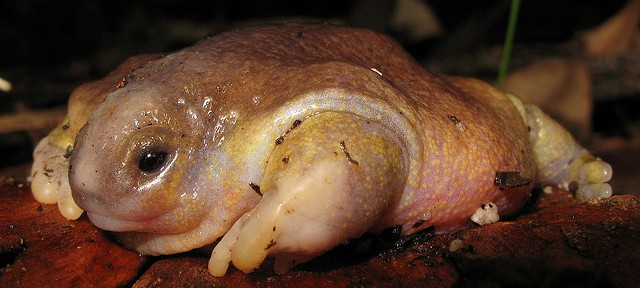Turtle Frog is a unique looking frog which is native to the western part of Australia. It is characterized by its peculiar body which looks like a small turtle without its shell. Mainly found in the semi-arid region, these frogs, unlike the other frogs, have short and muscular limbs. The strong limbs help them dig into the ground. One behavior which separates it from the rest of the frog is that unlike the other frogs, they dig forward like a turtle rather than backwards.
Turtle Frog Scientific Name
The scientific name for the turtle frog is Myobatrachus gouldii. It is the only species of the Myobatrachus genus.
Turtle Frog Description
Turtle frog is a peculiar frog which resembles a small turtle without a carapace. These frogs are very small and have an average length of about 2 inches (5cm). Their back is shiny and smooth with fine granules. Their belly is dirty white with brown flecks. They have round body with small head and tiny eyes. Unlike the other frogs, they have short but muscular limbs which helps them to dig the sand. The color of its back varies from light pink to deep brown.
Picture 1 – Turtle Frog
Turtle Frog Distribution
Turtle frogs are native to Western Australia. They are found in the southwest and central zones of west Australia. They range from Geraldton in the north and Fitzgerald River in the south eastern side. They are widely found across the coastal plains of Perth Region.
Turtle Frog Habitat
Turtle frogs are found in semi arid environment. They inhabit the open woodlands, places of leached grey sand and dense scrubs in sand hills. Their habitat is generally associated with termite colonies as they feed on termites. They hide under logs and stay underground most of the time. They emerge to the surface after the rain.
Turtle Frog Reproduction
Mating occurs after a heavy rain when the turtle frogs come up to the surface. The mating call of the turtle frog varies regionally. Once they choose their partner, they retire to their burrow.
Turtle Frog Eggs
A clutch of 15 to 40 eggs are laid. Turtle frog eggs have an average diameter of 6mm and are one of the biggest eggs laid among the Australian frogs.
Turtle Frog Tadpoles
The species of Turtle Frog do not have a tadpole stage; instead it develops fully inside the egg. The hatchlings are small fully developed frogs.
Turtle Frog Call
Their mating call is a deep croak from their burrow.
Picture 2 – Turtle Frog Photo
Turtle Frog Diet
Turtle frogs feed on termites and therefore they are found at the termite colonies.
Turtle Frog Interesting Facts
- They are native to the Western parts of Australia
- They are named Turtle Frog due to the fact that they resemble a small turtle without its carapace.
- They have small muscular limbs which helps them to dig the sand.
- Like a turtle, these turtle frogs dig forward rather than backward like any other frogs.
- Turtle frog does not have a tadpole stage; rather its embryo develops inside the egg.
- The eggs of the turtle frog are the biggest of all the Australian frogs.
- They lay 20 to 40 eggs at a time.
- They feed on termites hence their habitat is also associated with the availability of termite colonies.
- Turtle frogs can eat around 400 termites at a time.
- It burrows its head first into the sand.
- Turtle frogs are a close relative of the Sandhill frogs and have similar habits of digging forward and taking care of their young ones.
Turtle Frog Conservation Status
Turtle frog is not considered an endangered species and its population has remained stable. There is no threat that has been considered to this species as it occurs in an area secluded from human disturbances.
The possibility of any threat of the species would be due to the following:
- Stalinization, where the soluble salts gets accumulated in the soil.
- Changes in the habitat like clearance of the vegetation or growth of invasive species.
- Direct human impact due to urbanization
- Water pollution
Turtle Frog Pictures
Here are some of the pictures of this unique frog.
 Picture 3 – Turtle Frog Picture
Picture 3 – Turtle Frog Picture
Picture 4 – Turtle Frog Image
Reference:
http://www.strangeanimals.info/2011/09/turtle-frog.html
http://www.iucnredlist.org/apps/redlist/details/41171/0
http://frogwatch.museum.wa.gov.au/Southwest/SwanCoastalPlain/435.aspx
http://frogsaustralia.net.au/frogs/display.cfm?frog_id=52
http://thewebsiteofeverything.com/animals/amphibians/Anura/Myobatrachidae/Myobatrachus-gouldii




Leave a Reply